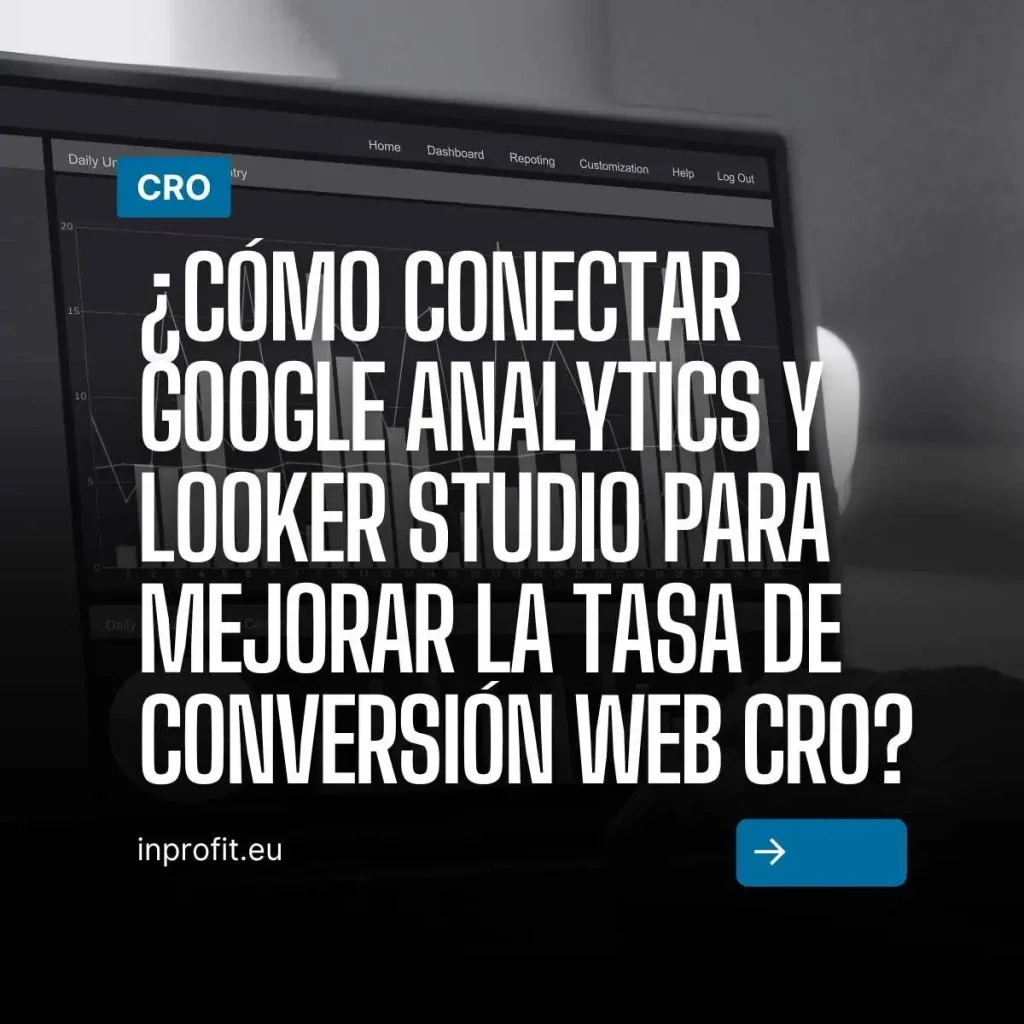To achieve this, it is essential to have tools that provide accurate data and clear visualizations to identify opportunities for improvement. Google Analytics 4 (GA4) and Looker Studio (formerly Google Data Studio) form a powerful combination to collect, analyze and visualize data, helping companies optimize their conversion funnels.
Today we will guide you step-by-step on how to connect GA4 with Looker Studio and how to use this integration to improve your CRO, with practical tips and application examples.
Why connect GA4 with Looker Studio for CRO?
Google Analytics 4 is an advanced web analytics tool that tracks user behavior, events and conversions on websites and apps. However, its native reports can be limited for complex or customized visualizations.
Looker Studio, on the other hand, allows you to transform this data into interactive and visually appealing dashboards, facilitating the identification of patterns, bottlenecks and opportunities in the conversion funnel.
By connecting GA4 to Looker Studio, you can:
- Visualize the conversion funnel: Create charts that show how users progress from recognition to final action (such as purchases or registrations).
- Identify friction points: Detect pages with high bounce or abandonment rates in the funnel.
- Segment audiences: Analyze the behavior of different groups of users (by channel, device or demographics) to customize strategies.
- Measure the impact of optimizations: Compare metrics before and after implementing changes, such as A/B testing or user experience improvements.
- Tomar decisiones basadas en datos: Obtener información en tiempo real para ajustar campañas de marketing y optimizar el diseño del sitio web.
This integration is especially useful for digital marketers, business owners and analysts looking to improve the effectiveness of their websites without relying on complex or expensive tools.
Step by step How to connect Google Analytics 4 with Looker Studio?
Before you begin, make sure you meet the following requirements:
- A Google Analytics 4 account set up with access to a property (you need “Read and Analyze” permissions as a minimum).
- Access to Looker Studio with a Google account.
- Google Signals enabled in GA4 (optional, but recommended for more complete demographics).
- Conversion goals or events configured in GA4 (e.g., purchases, registrations or clicks on a CTA).
Step 1: Login to Looker Studio
- Go to Looker Studio and sign in with your Google account.
- On the main page, click Create (top left corner) and select Data Source.
Step 2: Select Google Analytics Connector
- In the list of connectors, select Google Analytics.
- If prompted, click Authorize to grant Looker Studio access to your Google Analytics data.
- Choose the Google Analytics account associated with your GA4 property.
- Select the GA4 property you want to connect (make sure it is a GA4 property, not Universal Analytics).
- Click on Connect in the upper right corner.
Step 3: Configure the data source
- Once connected, the data source fields panel will appear, where you can see the metrics (such as sessions, conversions) and dimensions (such as channel or device) available.
- Customize the fields if necessary:
- Change field names to make them more descriptive.
- Create calculated fields for specific metrics, such as conversion rate (Conversions / Sessions).
- Click on Create report to start building your dashboard.
Step 4: Create a CRO report
- In the report editor, select the newly created data source.
- Use the drag-and-drop interface to add graphics. Some recommended visualizations for CRO include:
- Funnel chart: to visualize the stages of the conversion funnel (e.g., visits → product pages → cart → purchase).
- Bar chart: To compare conversion rates by channel (organic, direct, PPC).
- Time series chart: To analyze trends in conversions over time.
- Table: To display detailed metrics, such as bounce rates per page or conversions per device.
- Add filters to segment data (e.g., by country, device or traffic source).
- Set a date range to analyze data in specific periods (daily, weekly, monthly).
- Customize the design with colors, logos and fonts that reflect your brand identity.
Step 5: Configure automatic updates
- In the editing pane, select File > Report Settings.
- Set the update frequency (e.g., hourly or daily) to keep the data up to date.
- Save the report and share it with your team using the Share option (you can set read-only or edit permissions).
Technical note: Connection with BigQuery (optional)
Si tu sitio web maneja grandes volúmenes de datos o necesitas análisis más avanzados, considera conectar GA4 con BigQuery y luego usar Looker Studio para visualizar los datos. Esto evita las limitaciones de la API de GA4, como las cuotas diarias, y permite acceder a datos sin procesar. Para hacerlo:
- Configure GA4 integration with BigQuery in the GA4 interface.
- In Looker Studio, select the BigQuery connector instead of the native GA4 connector.
- Create custom queries to extract relevant data and visualize them in dashboards.
Using Google to optimize conversion rate
Once you’ve connected GA4 with Looker Studio, you can leverage the data to improve your CRO. Here’s a practical approach to optimizing your website:
Visualize the conversion funnel
- What to do: Create a funnel chart in Looker Studio to map the key stages of the user journey (e.g., home page → product page → cart → checkout → purchase).
- Key metrics: Conversions per stage, abandonment rate between stages, sessions per channel.
- Example: If you notice that many users abandon the cart, analyze the checkout page to identify problems such as long forms, lack of payment options or slow loading times.
Identify pages with high bounce rates
- What to do: Use a table to display bounce rates per page, filtered by channel or device. Add a bar chart to compare performance between pages.
- Key metrics: Bounce rate, time on page, events per session.
- Example: If the product page has a bounce rate of 70% on mobile devices, check the responsive design or the loading speed with tools such as PageSpeed Insights.
3. Segment by channels and devices
- What to do: Create charts comparing conversion rates by channel (organic, PPC, social) and device (mobile, desktop, tablet).
- Key metrics: Conversions per channel, sessions per device, conversion rate per device.
- Example: If organic traffic has a low conversion rate, optimize on-page SEO or improve landing page content.
4. Performs A/B testing based on data
- What to do: Use Looker Studio insights to identify underperforming pages or elements (such as CTAs). Implement A/B testing to test different versions.
- Key metrics: CTA click-through rate, conversions per variant, time on page.
- Example: If a CTA has a low click-through rate, try changing the text, color or position and measure the impact in Looker Studio.
5. Monitor trends over time
- What to do: Create time series graphs to track how conversion rates change after implementing optimizations.
- Métricas clave: Conversiones semanales/mensuales, tasa de conversión promedio, ingresos por canal.
- Example: If you introduce a new page layout, compare conversion rates before and after to evaluate its effectiveness.
6. Integrate other data sources
- Qué hacer: Conecta Looker Studio con otras plataformas, como Google Ads, Google Search Console o tu CRM, para obtener una visión más completa del rendimiento.
- Key metrics: Cost per conversion (Google Ads), best performing keywords (Search Console), customer lifetime value (CRM).
- Example: If your Google Ads generate a lot of sessions but few conversions, adjust your keywords or landing page design.
Practical tips to maximize CRO with GA4 and Looker Studio
- Use predefined templates: Looker Studio offers free templates for GA4, such as web analytics reports or conversion funnels. Customize them to save time.
- Avoid quota errors: If you use the native GA4 connector, be aware of the API limitations (limited number of daily requests). If you encounter quota errors, consider using BigQuery.
- Create narrative dashboards: Organize charts as a story, starting with an overview and breaking down by specific areas (acquisition, behavior, conversions). This makes it easy for non-technical teams to understand.
- Leverage GA4’s predictive metrics: Use GA4’s machine learning capabilities, such as anomaly detection or predictive auditing, to identify optimization opportunities.
- Update regularly: Review your dashboards periodically to include new metrics or adjust visualizations as your CRO strategy changes.
Example of dashboard for CRO
An effective dashboard for CRO could include:
- Page 1: Overview:
- Key metrics: Sessions, users, conversion rate, revenue.
- Graph: Conversions by channel (bars).
- Page 2: Conversion funnel:
- Funnel chart: stages of the user journey (visit → interaction → conversion).
- Table: Dropout rate by stage.
- Page 3: Analysis by channel:
- Bar chart: Conversion rate by channel (organic, PPC, social).
- Table: Sessions and conversions by device.
- Page 4: Page yield:
- Table: Bounce rate, time on page and conversions per URL.
- Time series chart: Trends in weekly conversions.
The power of a data agency
Connecting Google Analytics 4 with Looker Studio is a powerful strategy to optimize your website’s conversion rate.
By integrating detailed GA4 data with Looker Studio’s visualization capabilities, you can identify issues, uncover opportunities and measure the impact of your optimizations in real time. From creating conversion funnels to analyzing bounce rates per page, this combination allows you to make data-driven decisions to improve the user experience and increase conversions.
Para comenzar, sigue los pasos de conexión descritos, explora las plantillas de Looker Studio y personaliza tus dashboards según tus objetivos de CRO.
If you handle large volumes of data, consider integrating BigQuery for more robust analysis. With these tools, you’ll be one step closer to transforming your website into an efficient conversion machine.
If you need more information on how to set up events in GA4 or create advanced visualizations, please refer to the official Google Analytics and Looker Studio documentation.
Get started today and take your CRO to the next level!



